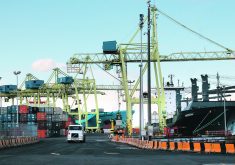One word that’s gone way out of fashion for 2022 is “transitory.”
That’s the term much-used early last year by many economists and central bankers in describing their outlook for inflation, which was rising as the world’s economies revived from the initial blow of the pandemic.
It was also used to describe the supply chain problems that have snagged and snarled so many industries, including agriculture.
The problems described then as transitory were expected to be gone by late 2021 or early 2022.
Read Also

Huge Black Sea flax crop to provide stiff competition
Russia and Kazakhstan harvested huge flax crops and will be providing stiff competition in China and the EU.
There are no signs now that either inflation or supply chain problems are getting better in any real way. Most analysts have booted their projections for lower inflation and fewer supply chain breakdowns to the second half of 2022 or into 2023.
For farmers, this is a very real problem. Crops, meat and other farm products can’t get out through the West Coast. California’s ports, for example, saw a nine percent slump in agricultural goods exports last year, right beside record imports.
In the other direction, inputs, equipment and technology can’t always get into North America when needed. Pandemic complications overseas are slowing factories, stranding supplies and confusing the usual trade flow.
Spring is just around the corner and the vital supplies for spring seeding aren’t necessarily going to be here on the Prairies in time.
This could hit farmers in many ways. Labour is already scarce in farm country and soaring wages in towns and cities aren’t going to make filling vacancies easy.
Input prices are already painfully high.
High crop and meat prices are part of the reason inflation is so high. If the world’s economies don’t continue to rebound from the pandemic, those high prices could be the sort of thing that sparks a recession.
Geopolitical tensions are high. There’s no way to safely predict the future of various tense situations, like the one along the Ukraine-Russia border.
There’s nothing much anybody can do to come up with a reasonable view of how all this is going on.
But I suspect analysts and prognosticators will be very careful with the words they use to predict what’s coming. The breezy “transitory” talk of 2021 doesn’t look great in retrospect.


















